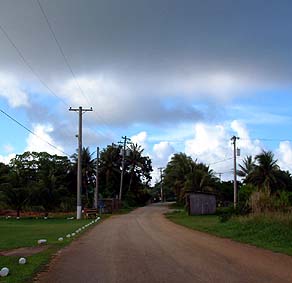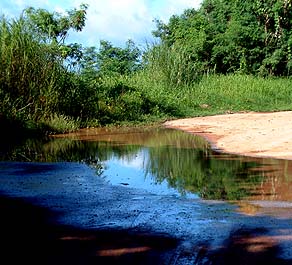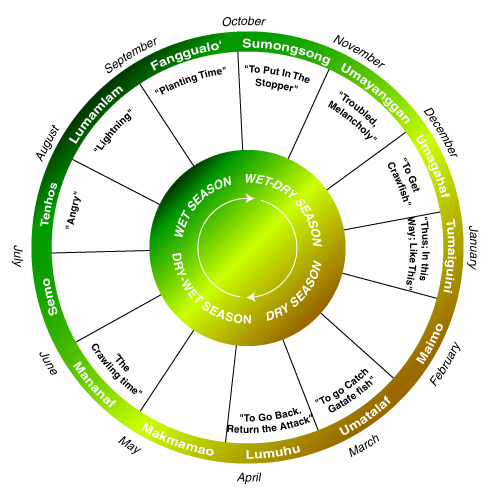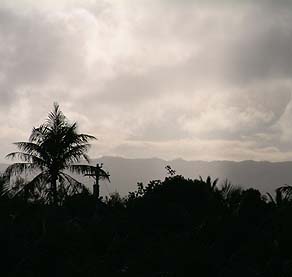 |
 |
 |
 |
||||
|
|
|
|
|
|
|
|
|
|
|
|||||||
|
|
|
|
|
|
|
“Rain is uchan," Ben explains. "Rain in our culture is so special, because it brings love and beauty. Depending on the way the rain is performing, when the rain comes down and it’s very strong, we consider that as 'madness.' When the rain comes down and just kind of drips, we call it 'the serenader,' where you play slow music. The Chamorro word is inserenata. When the rain kind of drips, we call it 'the ginago’, the lazy, lazy people. You become lazy, and when you become lazy, what do you do? You spend time with the one you love! "To me, as a Chamorro, rain is very sacred. Because Jesus used water to baptize people in his name. And where did the water come from? From the rain. So for our Chamorro people, it’s good to see rain, and we look at rain as a very special gift. In Chamorro rain is the gift of life. Without water, there is no life. Absolutely, I don’t care what anybody will say, there is no life. And I know that you agree with me."
|
||
|
|
||
|
“We have only two seasons here on Guam. The wet and the dry. Not like in the States, you have the summer, winter, autumn and spring,” Ben says. “Guam is a tropical area, and it rains a lot. "The season for rain is July-August-September, those three months. When it rains, it’s not like back in the U.S. Mainland where it rains day and night, full force. No, it rains really hard, then it stops, but it comes back again, on and off, on and off. "Or sometimes it rains for the whole day and a whole night, and
sometimes for three days, and then it stops, it dries up."
|
|
|
|
“It’s funny in Guam because it could be raining on the mountain, but not here. And that is the case here in Inarajan. You can see from sitting down here, it rains really heavy on the mountain, but not here. And in about eight hours from now, you will see the water in the bay turn red, and you are wondering, ‘What the heck is this? Where does it come from?’ "You forget that you have seen the rain in there. But imagine: when that rain that stays for four or five hours, that’s a lot of water. And that causes lot of erosion.
|
|
|
|
|
|
|
“We have a transitional period into the rainy season, which is late June," Rufo explains. "That’s the transition from dry to wet. Then the wet season runs until about the middle part of December. Then there’s a transitional period again, from December into January. Then we have our dry season.”
|
||
|
|
||
|
These two transitional periods are often referred to by combining the words "wet" and "dry." Rufo elaborates: “The 'dry-wet season' would be the June transition, because you’re going from the dry to the wet. And the 'wet-dry season' would be December-January. "In the wet-dry season, it’s a cool period for Guam. If you’re planning on visiting Guam, that’s the time that I would come to Guam! That’s the best time to visit. "Then there’s the dry season, for which I have heard the term used, ‘somnakum.’ Somnak is the sun."
|
June rains over Malojloj.
|
|
|
“In April we have April showers. That’s a short period there, and depends on the effects of El Niño and La Niña. But normally it’s April. When you see the farmers here, they start preparing their fields for planting to take advantage of that April rain. We usually have about two weeks of showers, and that’s sufficient. It provides sufficient moisture for the plants to grow and start flowering. "And then the farmers have to irrigate, because the plants continue
growing up until June and are harvested in late May or June, usually.
"Fortunately for us, this year [2002] is a wet, dry season. When you see the dry, dry season here, then you see smoke from the hillsides, fires."
|
|
|
|
|
Inarajan turns green with the onset of the wet season.
|
|
“When we look at rain and see rain, we think of the color green," Ben remarks. "The color green in Chamorro is betde. The color green, betde, means life. If you see green anywhere, it’s life, something is alive. We look at the earth and it is covered, it is cloaked with grass and trees, and what is the color? Green. As the water comes out, it brings out many good things. Betelnut. Coconut. Bamboo. All sorts of things that people pick and use. And if you see areas that are brown, it would mean not enough rain." Hence rain is intimately connected with the forest.
|
||
|
|
||
|
|
|
|
|
|

|
| Inarajan Home | Map Library | Site Map | Pacific Worlds Home |
|
|
|
|
|
|
|
|||
| Copyright 2003 Pacific Worlds & Associates • Usage Policy • Webmaster |
|||









